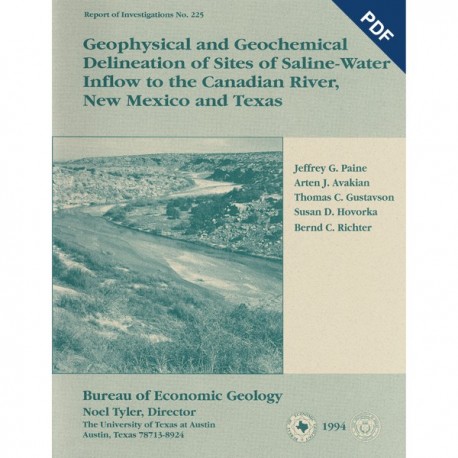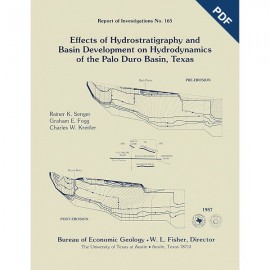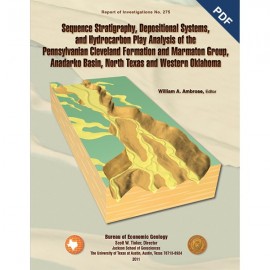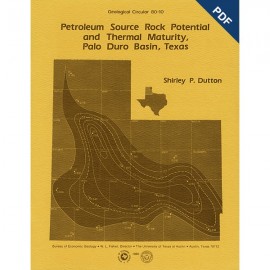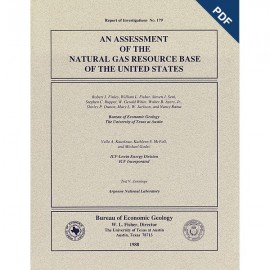Reports of Investigations
-
Books & Reports
- Reports of Investigations
- Guidebooks
- Udden Series
- Geological Circulars
- Down To Earth
- Atlases of Major Oil and Gas Reservoirs
- Texas Memorial Museum Publications
- Environmental Geologic Atlas of the Texas Coastal Zone
- Mineral Resource Circulars
- Other Reports
- Seminars and Workshops
- Handbooks
- Submerged Lands of Texas
- Symposia
- Annual Reports
- Open File Reports
-
Maps & Cross Sections
- Thematic Maps
- Miscellaneous Maps, Charts & Sections
- Geologic Atlas of Texas
- STATEMAP Project Maps
- Geologic Quadrangle Maps
- Cross Sections
- Highway Geology Map
- Energy and Mineral Resource Maps
- Shoreline Change and Other Posters
- Wilcox Group, East Texas, Geological / Hydrological Folios
- Bouguer Gravity Atlas of Texas
- River Basin Regional Studies
- Featured Maps
- Posters
- Teachers & the Public
-
Geological Society Publications
- Gulf Coast Association of Geological Societies
- Alabama Geological Society
- Austin Geological Society
- Corpus Christi Geological Society
- Houston Geological Society
- Lafayette Geological Society
- Mississippi Geological Society
- New Orleans Geological Society
- South Texas Geological Society
- GCS SEPM Publications
- Historic BEG & UT Series
Geophysical and Geochemical Delineation of...Saline-Water...Canadian River, New Mexico...Texas. Digital Download
RI0225D
For a print version: RI0225.
RI0225D. Geophysical and Geochemical Delineation of Sites of Saline-Water Inflow to the Canadian River, New Mexico and Texas, by J. G. Paine, A. J. Avakian, T. C. Gustavson, S. D. Hovorka, and B. C. Richter. 73 p., 58 figs., 4 tables, 1 appendix, 1994. doi.org/10.23867/RI0225D. Downloadable PDF.
To purchase this publication in book format, please order RI0225.
ABSTRACT
Lake Meredith, which supplies water for domestic use to all major Texas cities on the Southern High Plains, exceeds State of Texas limits for chloride and sulfate content. Locating sources of these solutes along the Canadian River, which supplies Lake Meredith, marks the first step toward a remediation effort to reduce river salinity and improve the water quality of Lake Meredith.
Our approach was to use surface-water conductivity and flow measurements, geological observations, and previous studies to identify areas where highly saline water enters the Canadian River, then complete detailed ground-conductivity studies in the probable inflow areas to locate discharge points.
Our measurements of conductivity and salinity of Canadian River waters indicated that the most important saline ground-water discharge areas are concentrated in two river segments between Ute Reservoir and Rana Canyon, New Mexico: one between the reservoir and a point 14 to 16 km downstream, and the other 32 to 64 km downstream from the reservoir. Chemical analyses of surface water and subsurface log data suggest that saline water in the Canadian River valley evolved by the mixing of fresh water derived from meteoric precipitation and highly saline water derived from dissolution of halite from the Permian San Andres Formation and the Artesia Group. Modern dissolution occurs along a front that lies about 335 m beneath the Canadian River in the Ute Reservoir area and that extends about 16 km south of the river at depths of 305 m.
Analysis of near-vertical joints in bedrock along the river valley indicates that the primary joints are oriented east-west and may be dilated and open to ground-water flow, whereas the secondary joints are oriented north-south, commonly terminate against the primary joints, and are not dilated. These observations are consistent with a hypothesis that saline water from depth preferentially flows into Canadian River alluvium through open bedrock joints, either directly beneath the Canadian River valley or indirectly beneath tributary valleys, and subsequently flows into the river.
Electromagnetic surveys, consisting of more than 2,200 ground-conductivity measurements along seven segments of the Canadian River and its tributaries, reveal that apparent conductivities in alluvium within the Canadian River valley range from a few to nearly 300 millisiemens per meter. Three broad high conductivity zones, ranging from 1.6 to 4.2 km long, were detected between Ute Reservoir and Revuelto Creek; a fourth high-conductivity zone, 2.7 km long, was located 35 km downstream in the Dunes area. Each zone spans a number of individual conductivity peaks that range from 60 to 320 m across and may represent discrete brine discharge sites in Canadian River alluvium. Many of these peaks are located where tributary drainages enter the main Canadian River valley. Conductivity profiles computed from vertical electromagnetic soundings show increasing conductivity with depth at most sites.
Keywords: Canadian River, eastern New Mexico, electromagnetic methods, induction methods, New Mexico, salt dissolution, soil conductivity, Texas, Texas Panhandle, water chemistry, water quality, water salinity
CONTENTS
Abstract
Introduction
Problem
Objectives
Previous Studies
Geologic and Environmental Setting
Methods
Subsurface Stratigraphy and Evaporite Dissolution
Joint Analysis
Surface-Water Quality Survey
Electromagnetic Surveys
Lateral Ground-Conductivity Surveys
Vertical Ground-Conductivity Surveys
Multiple-Coil-Separation Soundings
Time-Domain Soundings
Results and Interpretations
Evaporite Dissolution Patterns in Permian Salt-Bearing Strata
Halite (NaCl) Dissolution
Anhydrite (CaSO4) and Gypsum (CaSO4*2H2O)Dissolution
Joint Analysis
Orientation
Dilation
Distribution
Surface-Water Conductivity and Flow Survey
Surface-Water Chemistry
Lateral Ground-Conductivity Surveys
Ute Reservoir to beyond Revuelto Creek
Revuelto Creek
Claer Well Area
Jones Well Area
Dunes Area
Rana Canyon Area, Canadian River
Rana Arroyo
Vertical Ground-Conductivity Surveys
Multiple-Coil-Separation Soundings
Ute Reservoir to Revuelto Creek, Site MI40
Ute Reservoir to Revuelto Creek, Site M263
Ute Reservoir to Revuelto Creek, Site M412
Jones Well Area, Site M25
Time-Domain Soundings
Upland near Ute Reservoir, Sites PN and PS Ute Reservoir to Revuelto Creek, Sites P331, P388, P421, and P500
Revuelto Creek, Site P8
Dunes Area, Sites P2, P53, PP102, P122, P164, and P230
Discussion
Evaporite Dissolution and Water Flow, Conductivity, and Chemistry
Joints and Ground-Water Flow Paths
Ground-Conductivity Surveys
Drilling in Jointed Dockum Group Strata
Conclusions
Acknowledgments
References
Appendix: Wells Used in Structural Cross Sections A-A' and B-B'
Figures
1. Regional structural elements and simplified geologic map of the Canadian River valley
2. Lake Meredith historical water storage and chloride concentration
3. Stratigraphic nomenclature of rocks beneath the Canadian River valley
4. North-south structural cross section A-A' through the Ute Dam
5. East-west structural cross section B-B' through the Ute Dam area
6. Canadian River canyon at the confluence of the Canadian River and Revuelto
7. Maps of the Canadian River between Ute Reservoir, New Mexico, and Lake Meredith, Texas
8. White efflorescence along the Canadian River in the Dunes area, New Mexico
9. Comparison between field-measured and laboratory-measured chloride concentrations
10. Relationship between surface-water conductivity measurements at sample sites and chloride concentrations determined in the laboratory
11. Generalized geologic map of the Canadian River valley and adjacent areas in eastern New Mexico showing areas selected for electromagnetic surveys
12. Effective penetration depth of various coil separations and coil orientations of the Geonics EM34-3
13. Topographic map of the Ute Reservoir to Revuelto Creek area of the Canadian River canyon showing key station locations, test sites, and sounding sites
14. Topographic map of the Claer well area of the Canadian River canyon showing key station locations and axes of prominent tributary canyons
15. Topographic map of the Jones well area of the Canadian River canyon showing key station locations, sounding sites, and approximate outline of surface-collapse feature
16. Topographic map of the Dunes area of the Canadian River canyon showing key station locations and sounding sites
17. Topographic map of the Rana Canyon area of the Canadian River canyon showing key station locations
18. PROTEM 47/S transmitter input and receiver response
19. Decay of transient secondary electromagnetic field and time distribution of measurement gates for the PROTEM 47/S
20. Instrument configuration of PROTEM 47/S sounding
21. Simplified topographic map of the Canadian River valley between Ute Reservoir and Revuelto Creek showing locations of joint measurements
22. Simplified topographic map of the Jones well area along the Canadian River showing location of joint measurements
23. Simplified topographic map of the Dunes area along the Canadian River showing locations of joint measurements
24. Primary through-going joints and secondary joints terminating against primary joints in Dockum Group sandstone
25. Joint distributions along north-south and east-west lines southeast of station 423 on the Canadian River
26. Joint distribution southeast of station 423 on the Canadian River
27. Joint distributions at the foot of Ute Dam. southeast of station 388 along the Canadian River between Ute Reservoir and Revuelto Creek, and at the intersection of Revuelto Creek and the Canadian River
28. Conductivity and flow along the Canadian River between Ute Reservoir, New Mexico, and Lake Meredith, Texas
29. Conductivity and flow along first 16 km of the Canadian River below Ute Reservoir, New Mexico
30. Chloride concentrations in river-survey samples collected between Ute Reservoir, New Mexico, and Lake Meredith, Texas
31. Plots of calcium versus chloride, magnesium versus chloride, and potassium versus chloride for surface-water samples
32. Plots of calcium versus sodium, calcium plus magnesium versus sulfate, and sulfate versus chloride for surface-water samples
33. Plots of sodium versus chloride and bromide-to-chloride weight ratio versus chloride
34. Comparison of water samples from well producing from Permian strata, wells producing from Triassic strata, and Revuelto Creek, Yemi, Mexico
36. Plots of calcium versus chloride, sulfate versus chloride, and calcium versus sulfate for surface-water samples
37. Relative concentrations of chloride and sulfate in the Canadian River and its tributaries, Texas and New Mexico
38. Piper diagram showing proportions of major cations and anions in surface-water samples collected along the western part of the Canadian River
39. Piper diagram showing proportions of major cations and anions in surface-water samples collected along the eastern part of the Canadian River
40. Apparent conductivity along the Canadian River from Ute Reservoir to a point 1.5 km downstream from Revuelto Creek
41. Comparison of apparent ground conductivities in zone A, Ute Reservoir to Revuelto Creek
42. Apparent ground conductivities along three parallel EM34-3 transects at peak B4 in zone B
43. Apparent ground conductivity along the Canadian River in the Claer well area
44. Apparent ground conductivity along the Canadian River in the Jones well area
45. Apparent ground conductivity along the Canadian River in the Dunes area
46. Apparent ground conductivity along the Canadian River in the Rana Canyon
47. Apparent ground conductivity along Rana Arroyo
48. Multiple-coil-separation soundings at sites M140, M263, and M412 between Ute Reservoir and Revuelto Creek
49. Apparent ground conductivity versus penetration depth and best-fit computed conductivity model for multiple-coil-separation soundings at sites M140, M263, and M412, Ute Reservoir to Revuelto Creek
50. Multiple-coil-separation sounding near center of surface-collapse feature at Jones well site M25
51. Apparent ground conductivity versus penetration depth and best-fit computed conductivity model for multiple-coil-separation sounding (horizontal dipole orientation) near center of surface-collapse feature at site M25, Jones well area
52. Time-domain soundings at sites PN and PS on the upland near Logan, New Mexico
53. Time-domain soundings at sites P331, P388, P421, and P500 along the Canadian River between Ute Reservoir and Revuelto Creek
54. Time-domain sounding at site P8 along Revuelto Creek
55. Time-domain soundings at sites P2, Pj3, P102, P122, P164, and P230 along the Canadian River in the Dunes area
56. Comparisons of sodium versus chloride, calcium versus chloride, magnesium versus chloride, and sulfate versus chloride data from February 1992 river survey and previous investigations
57. Comparisons of sodium versus chloride, calcium versus chloride, magnesium versus chloride, and sulfate versus chloride data from February 1992 river survey and from riverbed piezometers from previous investigations
58. Potentiometric surface of lower Dockum Group ground water
Tables
1. Results of chemical analyses of water samples collected during the February 1992 conductivity survey of the Canadian River between Ute Reservoir, New Mexico, and Lake Meredith, Texas
2. Best-fit conductivity models for EM34-3 multiple-coil-separation soundings along the Canadian River between Ute Reservoir and Revuelto Creek and in the Jones well area
3. Best-fit resistivity models for PROEM 47/S time-domain soundings along the Canadian River between Ute Reservoir and Revuelto Creek and in the Dunes area
4. Annualized salt loading in Canadian River, Ute Reservoir, New Mexico, to Lake Meredith, Texas
Citation
Paine, J. G., Avakian, A. J., Gustavson, T. C., Hovorka, S. D., and Richter, B. C., 1994, Geophysical and Geochemical Delineation of Sites of Saline-Water Inflow to the Canadian River, New Mexico and Texas: The University of Texas at Austin, Bureau of Economic Geology, Report of Investigations No. 225, 73 p. doi.org/10.23867/RI0225D.
